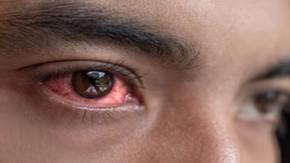These days, there is a rapid spread of eye flu in India. In this, people’s eyes become red along with swelling and irritation in the eyes. In today’s article, we will discuss in detail about eye flu – why it is spreading so rapidly, how dangerous it is, which virus is causing this, what its symptoms are, how to protect oneself from eye flu, and what to do if one gets eye flu.
What is Eye Flu
Eye flu, also known as conjunctivitis, is a common eye infection. It typically occurs due to viral or bacterial infections and can easily spread from one person to another. It is named conjunctivitis because it affects the conjunctiva, which is a membrane of the eye.
How dangerous is eye flu
Eye flu, in general, is not usually serious or life-threatening. It is commonly self-limiting, meaning it tends to resolve on its own after a certain period. In the majority of cases, treatment for eye flu is straightforward, and it often clears up on its own.
However, in some cases, particularly due to bacterial conjunctivitis, the duration of eye flu can be prolonged, and complications may arise. If bacterial conjunctivitis is not treated with antibiotics in a timely manner, it can spread within the eyes and lead to more severe eye infections such as corneal ulcers, which are infections in the central part of the eye.
Viral conjunctivitis can also be uncomfortable, but it generally resolves on its own, being self-limiting. In rare instances, it can lead to corneal infections, necessitating treatment.
In a few exceptional cases, eye flu outbreaks or epidemics occur, increasing the risk of eye flu within the population. In such instances, proper medical attention and treatment are essential
Types of eye flu
Eye flu mainly comes in three types:
The first is Viral Conjunctivitis: This type of conjunctivitis is caused by a viral infection, commonly by adenovirus. Viral conjunctivitis is contagious and easily spreads from one person to another. It involves watery discharge from the eyes, which can accumulate along the edges of the eyes. Sensitivity to light can also be experienced in this type.
The second is Bacterial Conjunctivitis: This conjunctivitis is caused by a bacterial infection. It results in thick yellowish-green discharge from the eyes. Like viral conjunctivitis, it is contagious and can spread from person to person. Bacterial conjunctivitis is treated with antibiotics.
The third is Allergic Conjunctivitis: This type of conjunctivitis is triggered by allergens such as pollution, dust, pet dander, or other substances that come into contact with the eyes. Symptoms include itching, redness, and watery discharge. Allergic conjunctivitis is non-contagious, meaning it does not spread from person to person.
History of eye flu
Mentions of eye flu can also be found in historical medical literature, although precise details of its history with specific dates and locations are not available. Generally, eye infections like eye flu have been observed from ancient civilizations to modern times.
Even in Ancient Egypt, references to eye infections and their treatments can be found. This civilization used various remedies for different infectious eye diseases, which often included the use of date molasses, honey, clarified butter (ghee), and different plants.
In Roman civilization as well, eye infections were treated using natural remedies. They would combine various herbal products and use clean water to clean the eyes.
Cases of eye flu also emerged during the Middle Ages, and during this time, treatments for eye infections primarily relied on herbal treatments and natural remedies.
With the advent of modern medicine, there have been advancements in understanding the causes and treatments of eye flu. This includes the popular use of antibiotics and other medications for infection control and treatment.
Virus of eye flu
There are several different types of viruses that can lead to eye flu, but the primary reason for it is usually adenovirus. Adenovirus is a common virus that causes respiratory infections such as cough, cold, and sore throat. Besides causing conjunctivitis, this virus is associated with various other health issues as well.
Adenovirus
Adenovirus is a group of viruses that can cause a wide range of infections in humans and animals. These viruses generally lead to respiratory infections and gastrointestinal infections. Adenoviruses come in various types, some of which are responsible for causing “eye flu.”
Adenoviruses are composed of genetic material in the form of RNA or DNA. These viruses are covered by a protein coat.
Adenoviruses mainly spread through respiratory droplets, such as coughing and sneezing. They can enter another person’s body through the respiratory secretions or eye discharge of an infected person.
Adenovirus infections are most commonly observed in children, especially young ones, as their immune systems are weaker. While these infections can also occur in adults, their immune systems are generally stronger, leading to less severe symptoms.
Certain strains of adenovirus cause conjunctivitis or “pink eye.” This viral conjunctivitis is contagious and easily spreads from person to person.
Some adenovirus strains lead to gastroenteritis, which includes symptoms like vomiting and diarrhea.
Adenovirus infections can sometimes occur in the form of outbreaks or epidemics, especially in crowded places, schools, or healthcare facilities.
Adenovirus infections are generally self-limiting, meaning they resolve on their own after a certain period. However, in severe cases, medical treatment is necessary.
To prevent adenovirus infections, it’s important to maintain good hygiene practices such as keeping hands clean, avoiding contact with infected individuals, and staying away from contaminated surfaces.
Why eye flu is spreading
Eye flu is a contagious eye infection that easily spreads from one person to another. This infection mainly spreads through direct and indirect contact. The primary causes of conjunctivitis are viral or bacterial infections. The virus or bacteria can reach another person’s eyes through contact with respiratory droplets or fluids from the infected person’s eyes.
The fluids that come out of the infected person’s eyes, such as tears and eye discharge, can spread by coming into contact with another person’s eyes. Therefore, if someone has eye flu, they should avoid touching their eyes with their hands and should regularly wash their hands.
Eye flu can also spread by touching surfaces contaminated with the infected person’s hands, towels, handkerchiefs, or other objects. Hence, it’s important to avoid direct contact with the infected person and not to share their personal items.
Close contact with the infected person, such as handshaking, hugging, or close talking, should be avoided.
Due to the ease of spreading eye flu, it can quickly propagate, especially in crowded places like schools, colleges, offices, or healthcare facilities. The infected person should keep a distance from others to break the chain of infection and prevent others from getting infected.
How to protect yourself from eye flu
To protect yourself from eye flu, you can follow some simple precautions and hygiene measures:
Washing your hands thoroughly is crucial, especially after visiting public places or coming into contact with an infected person. Before touching your eyes, make sure to wash your hands with soap and water for at least 20 seconds. After keeping your hands clean, avoid touching your eyes. Viruses or bacteria can easily reach your eyes from your hands.
Apart from your eyes, it’s important to refrain from touching your face, particularly your nose and mouth. This reduces the risk of spreading viruses or bacteria. If someone around you has eye flu, it’s necessary to avoid direct contact with them. Don’t share personal items with an infected person.
Maintain personal hygiene, including regular handwashing, keeping your face clean, and protecting your eyes from irritants. If eye flu cases are increasing in your surroundings, stay away from crowded places and avoid attending public gatherings.
Symptoms of eye flu
The symptoms of eye flu vary depending on the different types of conjunctivitis. However, there are some common symptoms that are observed when someone has eye flu:
In eye flu, there is redness in the white parts of the eyes. There is excessive watering from the eyes. Swelling around the eyes can occur. Itchy sensation in the eyes. In some cases, sensitivity to light may also be experienced.
In viral conjunctivitis, there is watery discharge that accumulates around the edges of the eyes, whereas in bacterial conjunctivitis, there is thick yellowish-green discharge that is closer to the eyes.
Is eye flu spread by eye contact
Eye flu can also spread by coming into contact with the eyes of an infected person. This is because the fluids that come out of the infected person’s eyes, such as eye discharge or tears, become contaminated with the virus or bacteria. If these fluids from an infected person’s eyes come into contact with another person’s eyes, conjunctivitis can develop in their eyes as well.
Rumors of eye flu
There are several misconceptions about eye flu.
The first misconception is that eye flu can cause blindness: This is not entirely true. If you ignore your symptoms or delay treatment, complications can arise, potentially leading to temporary vision problems or corneal ulcers in the central part of the eyes. However, with timely treatment, your vision is generally unaffected.
The second misconception is that once you’ve had eye flu, you won’t get it again: This is completely false. Eye flu is an infectious condition, so if you’ve been infected with it once, you can get it again in the future, especially if you have direct or indirect contact with an infected person.
The third misconception is that home remedies can cure eye flu: An important point to note is that your eyes are not something to experiment with. Home remedies like washing your eyes with cold water, putting rose water or cucumber slices on your eyes, or washing your eyes with milk are not effective treatments for eye flu. The treatment for eye flu depends on the type of infection, often involving the use of antibiotics, antiviral drugs, and other medications.
Solution of eye flu
The solution for eye flu depends on the specific condition, whether it is viral, bacterial, or caused by some form of allergy. This infection is generally self-limiting, meaning it tends to resolve on its own after a certain period, but bacterial conjunctivitis cases may require antibiotics.
In the treatment of eye flu, maintaining good hygiene is crucial. Regularly washing hands, avoiding touching the infected eye, and staying away from contaminated surfaces is important.
To keep the infected eye clean, it’s necessary to continuously clean eye discharge with tissue paper or a clean cloth. Additionally, gently cleaning crust formation is also important.
During the treatment of eye flu, your doctor may prescribe medicated eye drops or ointments. Antiviral or antibiotic eye drops are used for bacterial conjunctivitis.
During eye flu, it’s advisable to avoid eye makeup to prevent further infection spread.
If you experience symptoms of eye flu, consult an eye specialist or doctor. They will provide an accurate diagnosis and suggest appropriate treatment based on the type of infection.
Remember, if you have symptoms of eye flu, avoid self-diagnosis or self-medication. Consult an eye specialist or doctor for proper treatment. Since eye flu is contagious, it’s essential to avoid direct contact with infected individuals and maintain good hygiene. So, for awareness, please share this article and subscribe my youtube channel to receive our informative and awareness videos first. Until next time, Jai Hind.


